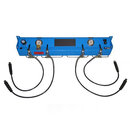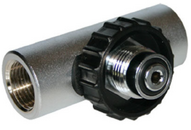GF99/99
Contributor
Hi Marsh,
Thanks for your reply. It was getting a bit lonely in this thread.
I bought those tanks in Sydney 21 years ago (new) and exported them to Africa in 1999. I am not sure if they would be any good now or not?
I agree with start small and keep it simple and will do that to kick off. But lots of logistical problems here. Its the 3rd world. Where I am on the lake is remote. We have one filling station in town and its often out of fuel. We have grid power but the grid is often down. We do have grid power most nights though and its cooler at night here (20 degrees C or so) so I was thinking it may be better to have some big tanks to fill at night then during the HOT.. (very HOT) to transfill to smaller tanks as I use them through out the day.
I have bought a new boat and 60HP outboard to dive from, bought the camera and underwater housing etc. Getting set to go....but then because of this forum remembered I have done nothing about figuring out AIR. So here I am.
I have a plot with waterfront to the lake. There is a small island offshore not to far away from me. I plan to blow bubbles in shallow water (10m) to hone my underwater photography skills before I go do the serious stuff in deeper water. I plan to do many many hours of blowing bubbles honing my skills. I will have to look up the dive tables again but I expect to get at least 2 x 1 hour dives per day in 10m of water. Plus my dive buddies who stay out on my perimeter on croc patrol need air too. So that's a lot of gas. Hence wondering if it makes sense to have a "bank" so that I only run a compressor at night to get longer life from filters (everything is imported here so everything hellish expensive) not to mention it being a lot easier/more convenient to "transfill" from a bank rather then start up a compressor every time I need to fill a few bottles.
I used to have 2 or 3 local divers diving with me (croc patrol) so we used to empty all 5 cylinders per day easily. There was a compressor locally back in the day but not now so have to figure it out for myself now.
While diving around the island close to is easy in terms of moving back and forth from home to the dive gorunds is easy its gets logistically difficult as I need to move further afield up the the lake (the lake is 700 Klms long and is very remote - its all in the bush). But I will deal with all that when I get to it.
I can get dive stuff from South Africa. There is a Bauer agent in JHB. So while its 3000 klms away from me to get to a service agent it is doable once a year.
Sorry to ask again but what is your budget?
No worries on the age of your tanks only hydro testing will determine if there good or not but most likely I'm sure there fine.
If your on a remote lake with grid power then I would suggest getting a gasoline or diesel driven compressor. You can fill in remote areas and you don't have to rely on grid power. If your looking to do 2 x 1hr dives a day then this is no problem for a basic small compressor. You would go for your dive then during your surface interval fill your tank then go for your second dive. Really I would not waste the money or time with setting up a huge air bank unless you have your heart set on it and your willing to spend the money. I personally have never set up an air bank nor do I know much about the but I understand the basic concept and for you the best bet would be to just make one your self out of several larger tanks then buy all the plumbing to connect them in series. Now if you really want to be able to fill 5 tanks with out having to start up your compressor and only off the air bank I think you would need a fairly substantial size air bank and your going to need 414 bar bulk tanks (I am assuming you will struggler to find these Zambia so most likely you will have to order them from the EU) and generaly these tanks are about USD $1,000 per tank not including shipping and import fees and you will need a couple of them in order to fill your tanks to 300 bar. The next option is to get 310 bar bulk tanks and once again I don't know how easy these will be to find in Zambia and with these you will only get 200bar fills maybe 250bar depending on how many you buy. Lastly your going to need a 414 bar compressor to refill your bulk storage tanks and a small one usually start at about USD $25,000. For maybe $10,000 you could probably get a 250 l/min gasoline or diesel drive compressor and just fill your tanks off that it would only tank about 20min to fill a tank to 300bar. And for half that price again maybe around $5,000 you could get a Bauer Junior II gasoline model.
Basically your looking at $30,000-$35,000 or more vs. $5,000 - $10,000 only to have the convivence of being able to fill you tanks up with out having to start up your compressor.
This is why I say its probably not worth it to setup and air bank. Just keep it simple and get a compressor and just fill your tanks off that. Best bet is to call up the Bauer dealer in SA and talk to them, they can inform you on what system is best for you needs.






